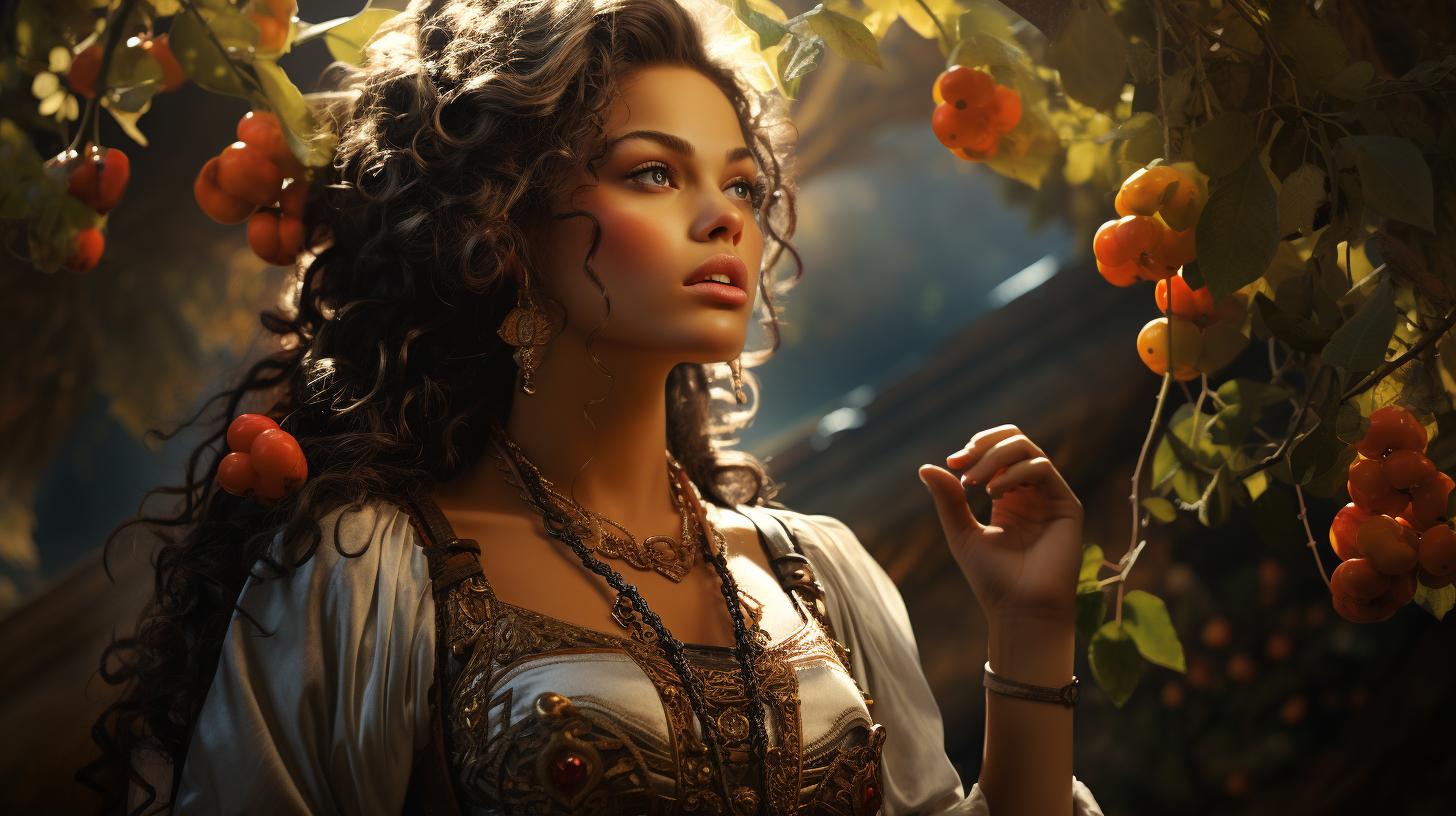Yarhibol the Ancient Aramean Deity

Yarhibol, an ancient Aramean deity, played a significant role in the city of Palmyra throughout its history. As the solar deity, Yarhibol was revered for his association with the sun and the renewal of life during spring.
Alongside the supreme deity Bel and other prominent gods like Aglibol, Yarhibol formed part of the diverse pantheon of gods worshipped in Palmyra. This article provides an overview of Yarhibol’s representation in Palmyra, examines the wider context of Palmyrene gods, and emphasizes the importance of preserving Palmyra’s rich cultural heritage.
The Ancient City of Palmyra
Palmyra, an ancient city located in present-day Syria, holds a rich historical significance.
Brief History of Palmyra
Palmyra’s origins can be traced back to the second millennium BCE. Over the centuries, it thrived as a bustling trade hub, attracting merchants from different regions. The city experienced periods of autonomy and control by various empires, including the Seleucids and the Parthians.
Importance of Palmyra in Ancient Times
Palmyra’s strategic location positioned it at the convergence of major trade routes, making it a vital crossroads for commerce between the East and the West. Its prosperity was further fueled by its abundant water sources, especially the oasis that sustained life in the arid desert surroundings.
Palmyra’s Role in Trade Routes
Palmyra’s central position allowed it to thrive as a key trading center along the Silk Road and the Incense Route. Caravans traversed the desert, bringing precious goods and facilitating cultural exchanges between the Roman Empire, Persia, and beyond.
This economic prosperity contributed to the city’s growth and cultural flourishing.
Understanding Yarhibol and Palmyrene Gods
In this section, we delve into the intriguing world of Yarhibol and the pantheon of deities worshipped in Palmyra.
Overview of Yarhibol, the Solar Deity
Yarhibol, a prominent Aramean god, holds significant importance in Palmyrene religion. Represented with a solar nimbus, he symbolizes the sun’s power and its association with vitality and renewal. Often referred to as the “lord of spring,” Yarhibol’s worship reveals deep connections to nature and the life-giving forces of the season.
Bel and Aglibol: Other Prominent Deities in Palmyra
Bel, considered the supreme god in Palmyra, stood alongside Yarhibol as a key figure in the local pantheon. Bel shares similarities with the ancient god Bel, suggesting a possible linguistic evolution of the deity’s name.
Aglibol, another prominent Palmyrene god, is often associated with Yarhibol and Bel, reflecting the interconnectedness of deities in the city’s religious landscape.
Examination of Arsu and Malakbel: Adopted Divinities
Palmyra also embraced divinities from various backgrounds, such as Arsu and Malakbel.
Arsu, a deity with military attributes, bears resemblance to the Greek god Ares. Malakbel, known as “the angel of Bel,” occupies a unique position within the Palmyrene pantheon, offering insights into the syncretic nature of religion in the ancient city.
This exploration of Yarhibol and the Palmyrene gods sheds light on the complex religious tapestry that once thrived in Palmyra, revealing the interplay between local deities and those borrowed from neighboring cultures.
The Representation of Yarhibol in Palmyra
Yarhibol, the Aramean solar deity, holds a significant presence in Palmyra’s rich history. This section delves into the various aspects surrounding Yarhibol’s representation in Palmyra, including the description of his stone panel, the significance of his nimbus and its association with spring, and the relationship between Yarhibol, Bel, and Aglibol.
Description of Yarhibol’s Stone Panel
The stone panel depicting Yarhibol’s head serves as a valuable artifact discovered in Palmyra’s columned street in 1957.
Dating back to approximately 150 AD, this rectangular piece, crafted from limestone, showcases the symbol of the sun god in exquisite detail.
Significance of Yarhibol’s Nimbus and Association with Spring
Yarhibol’s representation includes a distinct nimbo solar, symbolizing his connection with the sun. This nimbus highlights his association with warmth, light, and the renewal of life during the vibrant season of spring.
It exemplifies the deity’s role as the “lord of spring” and reinforces his significance in the Palmyrene pantheon.
Relationship between Yarhibol, Bel, and Aglibol
Yarhibol shares a close association with both Bel, the supreme god of Palmyra, and Aglibol, another prominent deity. Their interconnectedness suggests a harmonious relationship within the religious framework of Palmyra.
Together, these deities represent different aspects of the city’s cosmology and mirror the complex divinity worshipped by its inhabitants.
Exploring the Wider Pantheon of Gods in Palmyra
Introduction to Other Deities Worshiped in Palmyra
Palmyra’s rich religious landscape extended beyond Yarhibol and Bel, encompassing an array of other deities. These gods and goddesses held great significance in the spiritual practices of the city’s inhabitants.
- Arsu: A deity with strong militaristic associations, identified with the Greek god Ares.
- Malakbel: Known as ‘the angel of Bel’, this deity possessed a distinct connection with the chief god of Palmyra.
- Various other deities: Palmyrenes embraced a diverse range of divine figures from different origins, reflecting the cosmopolitan nature of the city.
Greek Influence on Palmyrene Gods and Goddesses
The Hellenistic influence had a profound impact on Palmyrene religious practices, leading to a syncretism between Greek and local deities.
This fusion resulted in the emergence of unique divine figures with blended characteristics.
- Greek deities in Palmyra: Gods and goddesses from the Greek pantheon, such as Zeus, Aphrodite, and Hermes, were incorporated into Palmyrene religious worship.
- Hybrid deities: The blending of Greek and local gods gave rise to hybrid deities, such as Zeus-Baalshamin, combining attributes from both traditions.
Iconography and Worship Practices of Palmyrene Deities
Palmyrenes expressed their devotion to these deities through various forms of iconography and rituals.
The depictions of gods and goddesses offered insights into their attributes and significance within the religious context.
- Artistic representations: Sculptures, reliefs, and architectural features portrayed the appearance and symbolism of Palmyrene deities, allowing worshippers to visually connect with them.
- Ceremonial practices: Rituals and offerings carried out by priests and devotees honored the deities and sought their favor for different aspects of life, including fertility, protection, and prosperity.
- Temple worship: Magnificent temples served as sacred spaces for devotees to engage in communal worship and connect with the divine presence of their chosen deities.
Preserving the Cultural Heritage of Palmyra
Importance of Documenting and Understanding Ancient Palmyra
Documenting and understanding the ancient city of Palmyra holds immense significance in preserving its cultural heritage.
By delving into the history, architecture, and social fabric of this remarkable city, we can gain valuable insights into the lives of its inhabitants and the rich cultural exchange that took place over the centuries.
Detailed documentation of archaeological sites, artifacts, and inscriptions allows future generations to study and appreciate the legacy of Palmyra.
Efforts to Preserve and Protect the Artifacts of Palmyra
Preservation and protection of the artifacts found in Palmyra are vital to safeguarding its cultural heritage. Collaborative efforts between local authorities, international organizations, and preservation experts ensure the conservation of archaeological sites, sculptures, inscriptions, and other valuable relics.
Implementing advanced conservation techniques, such as controlled climate environments and careful restoration, helps prevent deterioration and irreversible damage to Palmyra’s treasures.
Raising Awareness about Palmyra’s Shared Cultural Heritage
Creating awareness about Palmyra’s shared cultural heritage is crucial for fostering appreciation and understanding. Through educational initiatives, public exhibitions, and outreach programs, individuals and communities can learn about the significance of Palmyra and its enduring legacy.
By promoting cultural exchange, international collaborations, and responsible tourism, we can ensure that Palmyra’s cultural heritage remains a source of inspiration and admiration for generations to come.
.




















